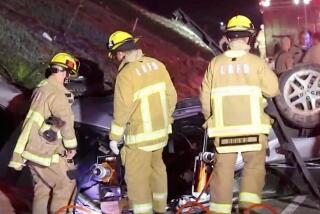Communities Welcome New Freeway Link
Entering a freeway onramp in a knot of cars and container trucks is a numbing daily ritual for millions of drivers.
But Pomona Mayor Eddie Cortez was ebullient Friday morning after traversing the new interchange connecting the Corona Expressway and Pomona Freeway.
“It’s beautiful,” he said.
Cortez and thousands of other commuters were among the first to use the new four-level interchange, which opened Friday, linking the two freeways.
At the crossroads of the county with the largest population in the nation--Los Angeles--and one of the fastest-growing--San Bernardino--the freeway junction was built to reduce rush-hour gridlock.
“I guarantee you that by this evening there will be a tremendous positive impact,” Cortez said after his inaugural ride.
The $68-million project, which took five years to complete, replaces an older-style interchange that Caltrans officials said could no longer handle the traffic load.
Traffic through the junction grew from 70,000 cars a day in 1977 to 197,000 cars a day. Caltrans expects traffic there to double by 2011.
On the old interchange, drivers had to cross several lanes of traffic. And the rush-hour bottleneck prompted many commuters to cut through local streets in Pomona, Chino and Chino Hills.
“A lot of my constituents were really ticked off” by the rumbling trucks and speeding commuters driving through their neighborhoods, Cortez said.
Chino Hills Mayor Eunice Ulloa said the spillover traffic has increased in the past few years, in part because of growth in Moreno Valley bedroom communities. “Our surface streets became alternatives to the freeways,” she said. “We took a tremendous hit.”
Along with commuters traveling between San Bernardino and Los Angeles and Orange counties, traffic to the Inland Empire has also grown along with new commerce and industry.
“Since we started this project, a lot of businesses have come in,” said Chia-Chi Wang, a Caltrans engineer. “It originally was a very different, much smaller area.”
Relief from congestion may not last long. Freeway construction often sparks heavy business and residential development nearby.
While the new interchange was being built, giant stores sprang up alongside, including a Home Depot, a Wal-Mart and a Chino Hills shopping center.
The Federal Highway Administration funded 80% of the interchange improvement. The state paid about $5 million, with Pomona contributing $7 million. Chino Hills paid $2.3 million.
More to Read
Sign up for Essential California
The most important California stories and recommendations in your inbox every morning.
You may occasionally receive promotional content from the Los Angeles Times.









